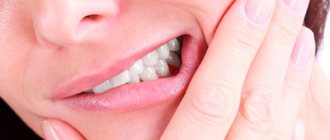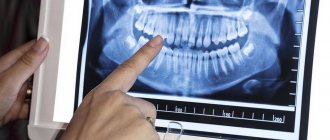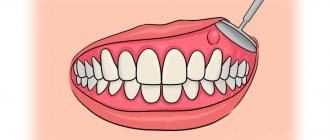From this article you will learn:
- why does the tooth under the crown hurt,
- what causes inflammation of the gums under the crown,
- how to treat a tooth under a crown.
There are only a few reasons why a tooth hurts under a crown. And almost all of them are associated exclusively with poor preparation of the tooth for prosthetics, i.e. with poor quality root canal filling. And here, if we look at the official statistics in dentistry, we will see that root canals are filled by dentists with poor quality even in more than 60-70% of cases. However, there are several other much less common causes.
For example, inflammation of the tooth under the crown, pain when biting and swelling of the gums can also occur in cases where living (not pulpless) teeth were taken under the crowns. In this case, the development of inflammation will not be associated with poorly filled root canals, but with a thermal burn of the pulp caused by the dentist during the process of grinding the tooth for a crown. In this case, one, several months or a year after prosthetics, the patient may first feel pain or other symptoms of inflammation.
As a rule, a burn of the pulp (neurovascular bundle) located in the center of the tooth occurs either due to insufficient water cooling of the tooth during the grinding of its hard tissues, but even more often due to the fact that the doctor is simply in a hurry. Also, another reason for the development of inflammation in a tooth under an artificial crown can be caries of the root of this tooth.
Prosthetics with crowns
Installing a crown on a tooth is a procedure to restore its anatomical shape, color, chewing function and aesthetics.
In practice, any tooth under a crown (with or without a preserved nerve) can begin to hurt. In this case, only a specialist can provide assistance. Lack of professional treatment or late contact with a doctor aggravates the situation; removal of the causative tooth may be necessary.
After professionally performed prosthetics, pain should not occur. At first, you may experience some discomfort associated with getting used to the new product in your mouth. If you have a crown installed and your tooth hurts, you should immediately tell your doctor about it.
Folk and pharmacy remedies for eliminating tooth pain under the crown
Let's talk about what safe folk remedies and medications from the pharmacy exist that you can use without risk to yourself to save yourself from suffering. The situation is simple, but at the same time complex. You don't know if your pain is temporary. If yes, then going to the doctor is a waste of time and energy in queues. That’s why many people think about how to proceed, how to relieve pain without outside help.
We heal with herbs
Don't forget that pain may be part of the natural adjustment process immediately after a crown is placed. But doctors warn that normally this can last no more than three days. This is approximately how much the gum needs to get used to the presence of a foreign body. If a tooth under a crown hurts for a week or more, it is better not to put off visiting a doctor. But we will assume that everything is fine and you are simply adapting to the installed dental prosthesis. So, what should you rinse your mouth with to relieve the condition?
It's no secret that the most popular remedy at all times has been sage. This medicinal plant was used by healers even before the baptism of Rus' and remains an effective remedy even now, with the development of pharmaceutical technologies. Rinsing with a decoction and infusion of this herb helps eliminate inflammation in the gums, bleeding, soreness, and other unpleasant symptoms. Sage also contains vitamins and microelements that are beneficial for periodontal tissues. To prepare the infusion, you will need 1 tbsp. l. dry herb (leaves), which can be bought at any pharmacy. Pour 200 ml of boiling water over them, cover and leave for 15 minutes. Rinse your mouth with the strained solution. If the problem is really an inflamed gum, you can easily fix it.
- Ceramic crowns
Sage decoction
Another medicinal plant that helps in such circumstances is oregano. It is in many ways similar in composition and properties to sage. Oregano contains phytoncides that destroy parasites and bacteria, and natural antiseptics such as thymol. In some situations, oregano turns out to be a safe analogue of antibiotics. To make a medicinal rinse, you will need to pour 1.5 tbsp of boiling water. l. herbs. Rinse your mouth with sage or oregano for half an hour. By repeating such procedures 2-3 times a day, you will significantly alleviate the condition.
Oregano decoction
The third popular remedy for pain and inflammation is baking soda. It not only helps relieve inflammation, but also significantly reduces the number of harmful bacteria in the oral cavity. Soda has no contraindications, is found in every home, and is cheap. It is versatile, practical and effective. To rinse, you will need a glass of warm water and a teaspoon of baking soda. Mix the powder thoroughly and use as a bath on the sore area in the mouth. There is no need to rinse your tooth with baking soda solution. Simply hold warm water in your mouth over the area where you feel pain. As soon as the water in your mouth cools, spit it out and draw a new one from the glass. Repeat until the pain subsides.
Soda
If the problem is in the gums, you will feel relief within 10-15 minutes.
Home first aid kit
If, after installing a crown, your tooth hurts, and rinsing does not give the desired result, you should take advantage of the achievements of modern pharmaceutical science. Fortunately, they are numerous and varied. The main thing is to read the contraindications so as not to harm yourself.
Dentists themselves often prescribe various tablets to patients to relieve pain after an intervention that is traumatic for the teeth and gums. These are Ketorolac and its derivatives - Ketorol and Ketanov, as well as Nurofen (Ibuprofen) or Tempalgin. In most cases, it is impossible to buy Ketorolac without a prescription. However, this drug is the most powerful pain reliever. It is prescribed even after bone fractures.
Tempalgin
Some patients try to save themselves with analgin. But its effectiveness is too low and the side effects are too serious to use tablets for toothache. The USA, Canada, Japan, Denmark and a number of other countries have long banned analgin, because it causes a decrease in neutrophils in the blood. Physiologically, this condition manifests itself in a decrease in the body’s resistance to bacteria and fungi.
Doctors also often prescribe antiallergic drugs – antihistamines. The fact is that bacteria in the oral cavity that cause inflammation secrete substances that the body perceives as a strong allergen. This results in swelling of the gums, pain, and other problems. There are many receptors in the human body. Each of them affects certain substances and types of exposure. One type of receptor senses histamines released by bacteria. In this case, the inflammatory process is the response of the immune system.
The most common remedies for eliminating such unpleasant symptoms are Suprastin, Diazolin, Tavegil, Claritin, Zyrtec, Diphenhydramine, etc.
Diphenhydramine
Some of these drugs have side effects or affect the reaction. For example, Diphenhydramine causes drowsiness and is often considered a sleeping pill. It is also important to follow the dosages indicated by the manufacturer of the medicine. If you buy a tablet separately without instructions, ask your pharmacist how to take the tablets correctly.
What you definitely should not do is buy antibiotics at the pharmacy. Not only will they not help relieve pain, but they will also lead to such a harmful phenomenon as dysbiosis. It will take a long time to restore the flora in the mouth and digestive tract. In addition, candidal or aphthous stomatitis may develop.
Aphthous stomatitis
10 effective drugs if the tooth hurts under the crown
| Name | Description | Price |
| Ketanov | An effective remedy for eliminating pain of various types, relieves inflammation after 30 minutes, when pain is acute. | 110 rubles |
| Nise | Has the ability to block pain, relieve inflammation and act as an antipyretic component | 220 rubles |
| Nurofen | Affects swelling, inflammation, relieves fever. The main advantage of the anesthetic is its rapid action (15-20 minutes after administration) | 110 rubles |
| Baralgin | The drug has an antispasmodic, anesthetic, antipyretic effect and is prescribed from the age of 15. Helps relieve minor pain | 255 rubles |
| Analgin | The drug can be rationally used for mild pain syndrome. The effect is observed 30 minutes after taking the tablet | 28 rubles |
| Dexalgin | It is rational to use for mild pain. For toothache, it is recommended to take 1 tablet. The effect occurs after half an hour, lasts 4-5 hours | 319 rubles |
| Paracetamol | The action is not inferior to Analgin, but is considered less dangerous. Suitable for cases where you need to get rid of mild pain | 50 rubles |
| Pentalgin | The composition of the medicine is multicomponent; in addition to paracetamol, it contains: caffeine, naproxen, pheniramine. It helps effectively relieve severe toothache | 150 rubles |
| Ibuprofen | The wide spectrum of action and properties of ibuprofen make the product effective for severe toothache | 20 rubles |
| Tempalgin | Use effectively for moderate or mild toothache. The tablet is taken before or after meals with an interval of at least 45 minutes. The drug begins to act in 30-40 minutes, the effect lasts about 1.5 hours | 120 rubles |
- How long does it take for drugs to leave the body?
Tooth hurts under the crown - treatment in the clinic
Any crown, even the most expensive one, does not last forever. The tooth underneath may begin to deteriorate. This, unfortunately, is a natural process. The service life of crowns is from 10 to 20 years, depending on the material used. If after some time your teeth hurt under them, then you need to go to the dentist, take a picture, and treat the tooth. Otherwise, you can easily lose it. This means that you will have to install a bridge or implant a titanium rod into the bone. Few people are happy with this prospect.
The question is when exactly did the tooth hurt - immediately, after a while or after many years. In most cases, the dentist involved in prosthetics refers the patient to a therapist to have the tooth re-treated or, if the problem is in the crown, he redoes it.
Crown on a tooth
It often turns out that while wearing the prosthesis, the stump began to deteriorate and pulpitis developed. We have to prepare the tooth, remove the destroyed nerve, and clean the canals. In some cases, it may turn out that while wearing a crown, a purulent inflammation has developed under the tooth, or a granuloma/cyst has appeared that needs to be removed. Sometimes the problem can only be solved by removing the causative tooth. The treatment plan and further prosthetics depend on the results of the diagnostics.
The most difficult time to eliminate such problems is during pregnancy. Half of the drugs, including anesthesia, are contraindicated. It is necessary to use the least dangerous means for the fetus. It is often recommended to postpone procedures to a later date.
At the dentist's office
Causes of pain
There are quite a few reasons why a tooth hurts under the crown, these include:
- Pulpitis is inflammation of the neurovascular bundle inside the tooth. The main cause of the pathology is infection in the root canal system, injury to the pulp. The disease can also occur when teeth are covered with a crown without removing the nerve. Pulpitis manifests itself as acute spontaneous pain, which over time may subside or become aching.
- Periodontitis is an inflammation of the periodontal tissues that surround the root of the tooth. The disease manifests itself when infection enters the periodontal space from the root canals. A common cause of pathology is poor-quality treatment or filling of canals. With periodontitis, the tooth hurts under the crown when pressing, eating, or applying pressure.
- Periostitis is an inflammation of the periosteum - the periosteum that surrounds the jaw bone. The disease occurs due to the spread of infection from surrounding tissues, often from poorly treated root canals. If the tooth under the crown hurts, the gums are swollen, or facial asymmetry appears, this indicates periostitis.
- Periodontitis is an inflammation of the gums, the circular ligament of the tooth and the tissues that surround and hold the tooth in the jaw. The disease can occur in the presence of somatic diseases of the body or an incorrectly installed tooth crown. Symptoms of periodontitis include bleeding gums, tooth mobility, pain, and bone destruction.
- Exacerbation of a chronic disease - cysts, granulomas . Decreased immunity can cause exacerbation of chronic inflammatory processes in teeth that are covered with crowns. Patients report acute pain in the tooth, swelling and redness of the gums.
- Sinusitis is inflammation of the mucous membrane of the maxillary sinus (maxillary sinus). The disease occurs due to infection in the sinus, disruption of the outflow of exudate, as well as from poorly treated maxillary molars (odontogenic sinusitis).
Other reasons why a “dead” tooth under a crown hurts include poor-quality canal treatment, the presence of nerve residues in the tooth, breakage of instruments in the canal, and the presence of inflammatory processes in periodontal tissues.
Symptoms
Inflammatory processes can be asymptomatic for a long time, but at some time it becomes painful when pressing on a tooth, biting or chewing on it. Acute pain indicates a serous or purulent lesion near the tooth. It puts pressure on the surrounding tissues, the pain is felt constantly, either subsiding or worsening. When the aching pain under the crown of the tooth is short-term in nature, occurring only when the prosthetic structure is loaded or when chewing, then the inflammation has become chronic, but this does not make it any less dangerous.
Other symptoms may accompany the pain:
- swelling, redness of the gums is a clear sign of an inflammatory process;
- flux (periostitis) - swelling affects not only the gums, but the face in the area of \u200b\u200bthe inflammatory focus, the prosthetic unit and the teeth nearby ache. The purulent cavity must be opened, drained, and treated with antiseptic;
- cyst under the crown - forms near the root apex due to periodontal inflammation. Initially, a granuloma is formed, grows, becomes covered with a durable membrane of connective tissue, and transforms into a capsule with purulent contents (cyst). It grows, accompanied by pain, swelling, redness of the gums;
- formation of a fistula - the purulent contents increase in volume, a channel is formed for its outflow. In the best case, it forms in the gums, in the worst case, pus spreads deep into the tissues, affecting the jaw bone, causing osteomyelitis.
During the first days after treatment, slight pain when loading the prosthesis is a normal physiological reaction of tissues to the intervention. But if a pulpless tooth under the crown hurts for a week or more, the pain is severe and interferes with eating, sleeping, and speaking, you should immediately go to the doctor.
What to do at home?
If a tooth with a crown hurts, then you need to quickly visit a specialist - a dentist. Before visiting a doctor, you can take the following measures:
- Take a pain reliever. It is better to use medications from the group of non-steroidal anti-inflammatory drugs - Paracetamol, Nimesil, Ibuprofen, Tempalgin, Ketanov;
- Carefully carry out hygienic cleaning of teeth and interdental spaces;
- Rinse the mouth with decoctions of medicinal herbs;
- Rinse with a salt-soda solution every 1-2 hours. To prepare the solution, you need to dissolve 1 teaspoon of salt and soda in 200 ml of boiled, slightly cooled water.
This cannot be done!
Often, in an effort to relieve pain, patients resort to rather risky methods. Remember what you should never do if inflammation starts:
- taking antibiotics without a doctor’s prescription - at best it will not bring results, at worst it will lead to serious health problems;
- warm the sore spot - elevated temperature favors the proliferation of pathogenic microorganisms, so such “treatment” will only worsen the condition;
- It is undesirable to take a horizontal position so as not to increase blood flow to the diseased tooth.
And finally, you should not let the situation take its course in the hope that the pain will go away on its own. It won't work! In order to get rid of pain, a doctor’s intervention or his recommendations are often necessary.
Treatment methods
If a tooth without a nerve hurts under the crown, the specialist will determine the cause of the pain and apply the most appropriate treatment method. Most often, the artificial crown is removed, as it will interfere with the treatment. But sometimes specialists carry out therapy without removing the structure. A small hole is made on the chewing surface of the tooth and crown through which treatment procedures are carried out. Depending on the clinical situation and the cause of tooth pain under the crown, treatment tactics may be as follows:
- Removing the crown and making a new one. The doctor eliminates the inflammatory process, treats and re-seals the canals.
- Crown removal, treatment and re-fixation. If possible, after treatment, the doctor can install the same crown on the tooth. But this method is rarely used, since more often the structure is deformed during removal.
- Treatment through a crown. Treatment of lateral teeth in some cases can be carried out through the structure, provided there is good access.
- Removing the crown and performing tooth-preserving surgery. To preserve the tooth as a functional unit, operations are used that involve removing the source of inflammation with part of the tooth: hemisection (removal of one root), coronary-radicular separation (removal of half the tooth), resection of the apex (removal of the upper part of the root from the sites of inflammation, cyst) .
- Tooth extraction is a last resort measure of treatment, which is used when it is impossible to save the tooth with therapeutic methods.
What happens if you ignore warning signs?
If inflammation is not eliminated, over time the pathological process will destroy bone tissue, which will lead to loss of teeth. In addition, pus accumulated in soft tissues can enter the intermuscular space or subcutaneous area. This can lead to melting of nearby tissues, requiring the intervention of an oral and maxillofacial surgeon.
It is difficult to treat a prosthetic tooth; this will require unfilling the canals, conducting anti-inflammatory therapy, and filling the canals again. If the inflammation has affected the root apex, surgical intervention will be required - resection of the apex along with the granuloma or cyst.
The doctor decides how to relieve pain under the crown individually in each clinical situation, based on the cause, stage, and extent of inflammation. Sometimes the situation goes so far that the only effective treatment method is the removal of a tooth followed by prosthetics.
Prevention
To prevent such a complication as pain in the tooth under the crown, it is necessary to carefully prepare and treat the teeth. Teeth under crowns must be treated very carefully and efficiently, and the root canals must be fully sealed. Patients are advised not to skimp on treatment, but to choose a reliable, proven clinic and a competent specialist who has modern equipment and materials at his disposal.
Dentists recommend careful care of your oral organs. You need to brush your teeth at least 2 times a day, clean the interdental spaces with dental floss and an irrigator. And every 6 months visit the dentist for professional hygiene and preventive examination.
If your gums hurt
Patients with a newly installed metal-ceramic crown often feel that the newly prosthetic tooth hurts. But in reality, this is a phantom feeling. After all, pain is manifested at this moment by the area of the gum on which the edge of the crown presses. There are two options.
- The sharp edge of the product constantly damages the periodontium, causing inflammation and pain. The pain intensifies and begins to radiate to the tooth. Very often in such circumstances it is difficult to understand where the source of pain actually is.
- If the edge of the crown is higher than the edge of the gum, food debris gets stuck in the gaps. Over time, this leads to the decomposition of these particles, massive proliferation of bacteria, and inflammation. The tooth really begins to decay along the crown. It rots, pulpitis begins and, as a result, acute pain. Thermal and chemical reactions appear. So, if you couldn't understand why a tooth can hurt from hot or cold, here's a logical answer.
Overhanging edges of crowns
When is pain normal?
Even a perfectly installed crown can provoke painful sensations immediately after prosthetics - as the local anesthesia wears off. The pain may be constant or occur with pressure. How to distinguish these sensations from those caused by pathology?
Firstly, pain normally lasts no more than 1-3 days - this is due to the adaptation of tissues to the new structure in the oral cavity.
Secondly, the pain tends to subside. Increasing sensations indicate a pathological process.
What can cause hyperesthesia?
Caries
Focal demineralization of enamel and destruction of tooth tissue leads to the formation of a cavity in dentin. This, in turn, opens access to external irritants directly into the hypersensitive pulp. If treatment is not started in time, the process naturally leads to periodontitis, pulpitis and ends in tooth loss.
Thinning enamel
Intensive loss of enamel due to its rapid abrasion leads to exposure of dentin and a painful reaction of the tooth to any external influences. There are many reasons for enamel depletion: malocclusion, bruxism, fluorosis, incorrectly selected dentures, tooth loss, leading to increased stress on the remaining dentition. Among the pathologies that thin the enamel, there may also be pathologies not directly related to the condition of the teeth. These are, for example, hormonal disorders.
Cracks in enamel
Even microcracks and microchips in tooth enamel can lead to the development of a painful reaction to cold and hot. The cracks make it easier for external irritants to access the pulp.
Wedge-shaped defect
Like the previous reason, a wedge-shaped defect refers to non-carious pathologies of hard tooth tissue. It is characterized by the formation of a wedge-shaped lesion in the area of the tooth neck. Most often, pathology occurs on the front teeth. Its causes are periodontitis, damage to the enamel by external factors (for example, the wrong toothbrush, toothpicks, etc.), and inadequate oral hygiene. A wedge-shaped defect is the most vulnerable place in tooth enamel and dentin, facilitating access to the pulp by external factors.
Erosion of tooth enamel
The next non-carious lesion is erosion of tooth enamel and, sometimes, dentin. The definitive cause of this pathology is not clear. There are versions about its mechanical origin or development due to hormonal and metabolic disorders.
Hypoplasia
Sometimes the cause of dental hypersensitivity is underdevelopment of the tissues or the entire tooth during its formation. This pathology is irreversible and leads to many problems, of which hypersensitivity is not the most unpleasant. As a rule, treatment consists of filling the affected tooth or placing it under a crown in order to eliminate the effects of external factors on the tissue.
Necrosis
Hard tooth tissues can undergo necrosis due to a variety of reasons - from disturbances in the functioning of the central nervous system to exposure to acids and alkalis. Dead enamel does not protect the tooth well, which leads to pain and temperature reactions.
Periodontal pathologies
Any inflammation of the periodontal tissues (periodontal) also leads to painful manifestations and threatens tooth loss. In addition, the periodontium is a tissue rich in nerve endings, and excessive exposure to it is in itself unpleasant.
Other reasons
Other causes of enamel damage include a variety of external factors. These include:
- some dental procedures, including dentures, whitening, fillings and nerve removal,
- improper care with unsuitable devices and hygienic compositions,
- deficiency of minerals and vitamins in the body: calcium, fluorine, vitamins C and D, magnesium. The lack of active substances provokes the destruction of enamel. This is especially true for children, the elderly and pregnant women.
Signs of inflammation
You need to pay special attention to the following symptoms:
- Pain. Most often, its cause is inflammation of the soft tissue under the crown or irritation of the root canals.
- Edema. This is a signal that inflammation has begun.
- A fistula is a channel from which pus comes out; it may appear some time after swelling.
It is worth remembering that after prosthetics, the first two to three days may be uncomfortable. In this case, you do not need to take any additional measures; if pain interferes with the usual course of business, take pain medications.
A pulpless tooth hurts
If the pulp has been removed, the pain is most often aching. It can radiate to the temple or ear. The main reason for this phenomenon is the exacerbation of chronic periodontitis. The choice of therapy method is determined by the presence or absence of a pin in the tooth root canal:
- there is no pin: the doctor opens the crown, unseals the root canals and treats them properly, after which he places materials impregnated with antibacterial agents into the tooth. Several changes to the medication may be required until complete relief is obtained and the inflammatory process is eliminated. After the symptoms have completely subsided, the canals are filled again and a new crown is installed;
- there is a pin: the doctor can cure periodontitis through surgery - resection of the apex of the tooth root. It is performed through a small incision in the gum, through which the source of infection is removed, and if necessary, the resulting void is filled with osteoplastic material. Typically, the intervention lasts from 30 to 60 minutes and is well tolerated by patients.










